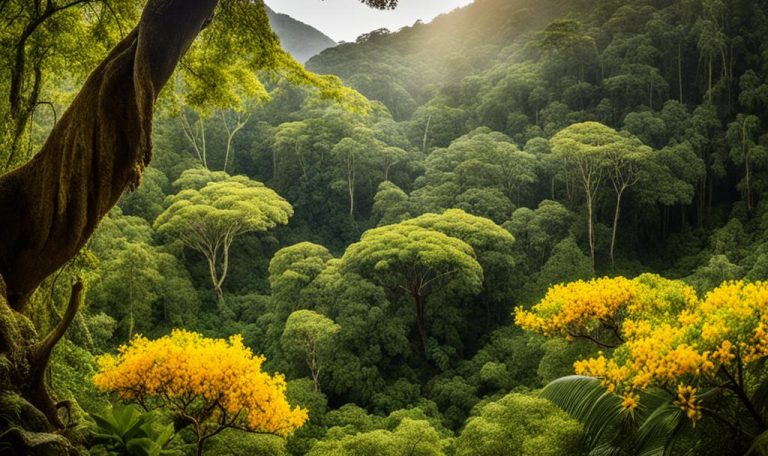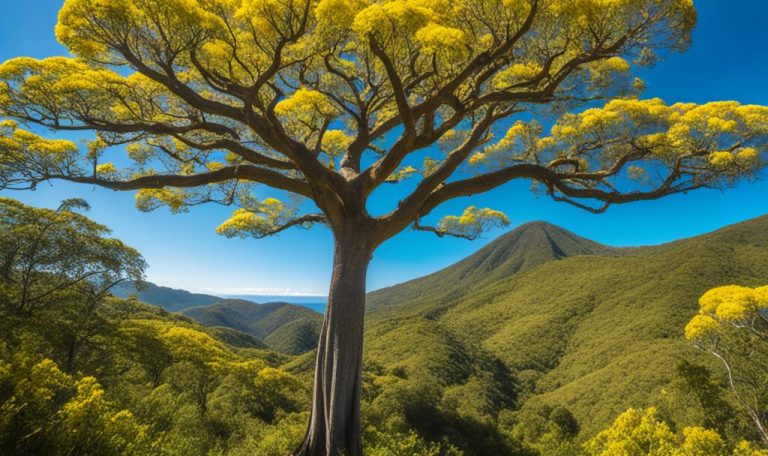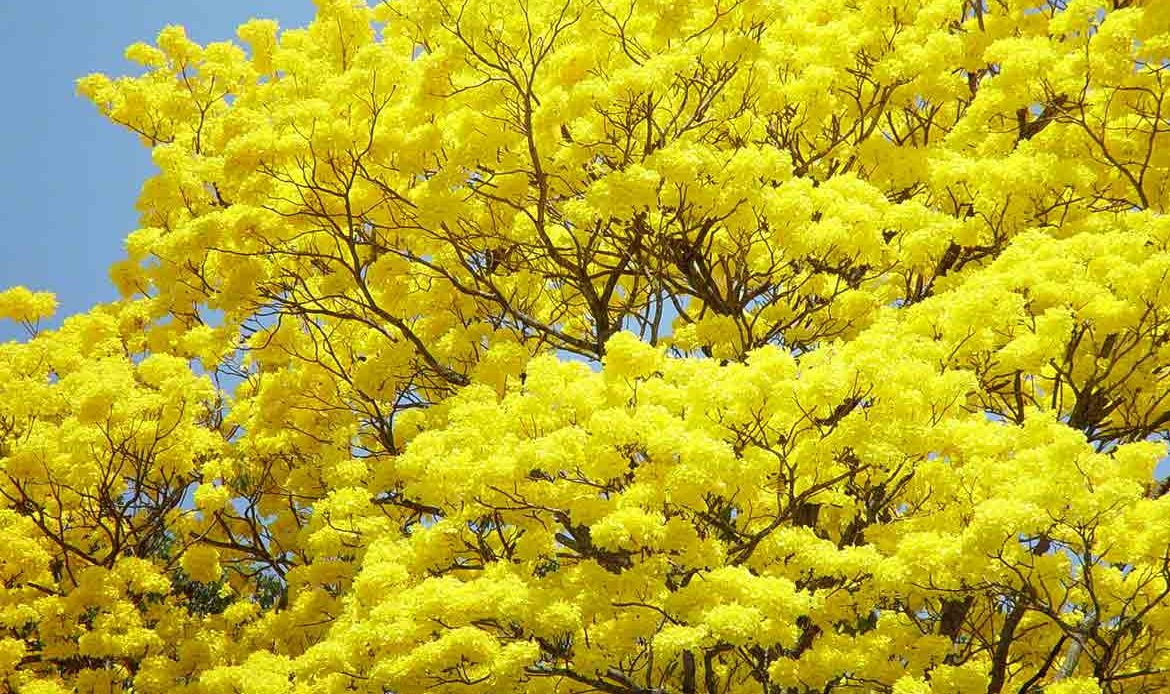Every year, between the months of March and April, Panama becomes a canvas painted in vibrant yellow. This awe-inspiring visual spectacle is none other than the annual bloom of the guayacan trees, a native Panamanian tree that deserves our appreciation. While not endemic to Panama, these trees can be found in the interoceanic canal area, where the oldest ones, aged between 40 and 50 years, reach their climax. It takes these slow-growing trees 10 to 15 years to produce their very first flowers, depending on factors such as soil conditions and humidity.
The guayacan trees are a unique sight to behold and serve as a reminder of nature’s beauty. Their annual bloom has become an event that locals and visitors alike eagerly anticipate, bringing a kaleidoscope of colors to the Panamanian capital. In recent times, with the city experiencing high levels of environmental pollution, this natural wonder has gained even more significance.
Key Takeaways:
- The guayacan trees bloom annually in Panama, adorning the city with vibrant colors.
- The climax of these slow-growing trees occurs between March and April.
- Factors such as soil conditions and humidity influence the timing of their bloom.
- The guayacan trees are not native to Panama, but they have become part of the country’s identity.
- The annual bloom is a must-see and showcases the beauty of Panama’s natural heritage.
The Guayacan Trees: A Natural Wonder
The guayacan trees, although not native to Panama, grow naturally in the country’s forests, particularly in the interoceanic canal area. Each year, their flowering becomes a visual spectacle that adds vibrant colors to the Panamanian capital. In recent months, the city has experienced high environmental pollution, making the annual bloom even more significant.
These guayacan trees can reach heights of up to 50 meters and require ample precipitation during their initial stages of growth. Their ability to bloom synchronously indicates the change of season, with their flowers marking the end of summer.
In the midst of environmental pollution, the vibrant bloom of the guayacan trees in Panama City serves as a stunning reminder of the beauty that nature can still provide.
Aside from their ornamental beauty, the guayacan trees also have valuable wood. Their presence in Panama City’s urban landscape adds to the city’s charm and natural beauty, making them a beloved feature of the cityscape.
The Significance of the Guayacan Trees
- The guayacan trees create a visual spectacle every year, bringing vibrant colors to the Panamanian capital.
- This event is especially significant in a city facing environmental pollution, as it serves as a reminder of the natural wonders that still exist.
- The guayacan trees reach impressive heights of up to 50 meters, contributing to the grandeur of the city’s skyline.
- Their ability to bloom synchronously indicates the change of season, marking the end of summer in Panama.
The annual bloom of the guayacan trees is a natural wonder that captures the hearts and attention of locals and visitors alike. It serves as a testament to the resilience of nature amidst environmental challenges, offering a moment of respite and beauty in the bustling Panamanian capital.
| Key Points | Details |
|---|---|
| Tree species | Guayacan trees |
| Main location | Forests in the interoceanic canal area |
| Height | Up to 50 meters |
| Blooming period | Annually between March and April |
| Importance | Visual spectacle and natural beauty |
The guayacan trees’ bright bloom amidst environmental pollution is a poignant reminder of the power and resilience of nature.
The Impact of Climate on Guayacan Blooms
In recent years, Panama has experienced the impact of the El Niño phenomenon, leading to drought and a decrease in rainfall. These climate conditions have had an effect on the flowering patterns of the guayacan trees to some extent. While most of these trees bloom synchronously, the changes in precipitation and weather patterns caused by El Niño have resulted in variations, with some trees blooming earlier in December or later in May.
The guayacan trees have a natural clock that detects the arrival of rains, triggering their flowering. However, the disruption caused by the El Niño phenomenon has altered this cycle. The scarcity of rainfall during the typical blooming season affects the timing of the guayacan trees’ blossoms. This climate impact highlights the sensitivity of these trees to changes in their environment.
Flowering patterns are directly influenced by precipitation levels, as the guayacan trees rely on a sufficient water supply to initiate their blooming process. With decreased rainfall during the El Niño period, some trees may not receive enough moisture to fully develop their flowers, resulting in delayed or diminished blooms.
Despite the challenges posed by the El Niño phenomenon, the guayacan trees’ resilience is evident as they continue to bloom, adapting to the fluctuating climate conditions. This adaptability showcases the strength of these trees and their ability to withstand environmental changes.

It is essential to monitor and study the impact of climate change on these valuable trees to better understand their ecological responses and ensure their long-term survival. Protecting the guayacan trees’ natural habitat and implementing sustainable conservation measures can aid in mitigating the negative effects of climate change on these remarkable flowering species.
A Kaleidoscope of Colors
In Panama, the guayacan trees offer a stunning array of colors, showcasing the diverse beauty of these magnificent species. With approximately seven distinct guayacan species found across the country, each tree exhibits its own unique flower colors, captivating the senses of onlookers. While the most well-known color of guayacan flowers is yellow, which paints the Panamanian capital during the annual bloom, other varieties also exist with mesmerizing hues of purple, pale pink, and pink.
The variety of flower colors in guayacan trees results from different genetic patterns within each species. These patterns not only determine the color of the flowers but also influence other characteristics, such as the shape of the blossom. As a result, guayacan trees exhibit a kaleidoscope of colors, adding vibrancy and splendor to Panama’s natural landscape.
The Diversity of Guayacan Species
Beyond the renowned guayacan trees in the canal area and Panama City, these diverse species and subspecies can be found in the lush and humid forests of other provinces, such as Colón, Chiriquí, and Darién. Each region offers a unique experience with its own combination of guayacan species and their vibrant colors, showcasing the rich biodiversity of Panama’s natural heritage.
Understanding the characteristics and diversity of guayacan species allows us to appreciate the immense beauty that nature has bestowed upon Panama. Whether it’s the familiar yellow blooms that dominate the cityscape or the lesser-known varieties with their captivating shades of pink and purple, the guayacan trees continue to mesmerize and inspire all who encounter them.
Take a moment to immerse yourself in the breathtaking diversity of guayacan colors:
| Guayacan Species | Flower Colors |
|---|---|
| Species 1 | Yellow |
| Species 2 | Purple |
| Species 3 | Pale Pink |
| Species 4 | Pink |
These are just a few examples of the guayacan species found in Panama. Each one adds its own unique touch of beauty to the country’s natural landscape, showcasing the splendor of nature’s palette.
Conservation Efforts and Protection
The guayacan trees are an essential part of Panama’s natural heritage and are protected under national legislation as a threatened species. These magnificent trees face various challenges due to their highly sought-after wood, which is used in ship decks, furniture, and tools.
To ensure the conservation of guayacan trees, the Ministry of the Environment in Panama has implemented strict regulations. Any export of guayacan wood requires permits issued by the Ministry, which aim to control and monitor the trade. These permits help prevent overexploitation and ensure the sustainable use of guayacan resources.
Furthermore, the guayacan trees are on the path to receiving international protection through their potential listing under Appendix 2 of the Convention on International Trade in Endangered Species of Wild Fauna and Flora (CITES). This would provide them with additional safeguards and further restrict their international trade.
“Through national legislation and international collaboration, our goal is to safeguard the future of guayacan trees and protect them from illegal logging and habitat destruction,” says Maria Rodriguez, an environmental conservation specialist.
The efforts to conserve guayacan trees reflect the commitment of Panama and the international community to preserve biodiversity and maintain a balance between human activities and nature. By protecting these trees, we ensure their survival for future generations to appreciate and enjoy.

The Beauty Within Panama’s Capital
Panama City is not only a bustling metropolis but also home to the beautiful guayacan trees. While the exact number of guayacan trees in the capital is not specified, various planting initiatives have been undertaken to bring their presence to different parts of the city. These initiatives contribute to the beautification of Panama City, creating a greener and more vibrant urban landscape.
Guayacan trees can be found in several prominent locations throughout the capital, allowing residents and visitors alike to witness their annual bloom firsthand. One such location is Parque Omar, a popular park that offers a serene escape from the city’s hustle and bustle. Camino Real de Bethania, Vía Italia, and Plaza Catedral are other notable areas where these majestic trees can be admired.
The presence of guayacan trees in Panama City adds to the charm and natural beauty of the urban landscape.
These iconic guayacan trees not only serve as city landmarks but also enhance the overall aesthetics of Panama City. Their vibrant yellow blooms create a captivating contrast against the city’s modern architecture and provide a unique sense of tranquility amidst the urban environment.
Planting Initiatives for a Greener Future
The planting initiatives aimed at increasing the guayacan presence in Panama City highlight the city’s commitment to sustainable development and environmental preservation. By introducing these trees to different areas, the city ensures that future generations will also have the opportunity to witness the annual bloom and appreciate the beauty of nature.
These planting initiatives not only benefit the visual appeal of the city but also contribute to the ecological balance. Guayacan trees provide shade, attract wildlife, and improve air quality, making Panama City a greener and more livable place for its residents.
City Landmarks Brimming with Natural Beauty
With their vibrant yellow blossoms, the guayacan trees have become an integral part of the city’s identity and a beloved city landmark. The annual bloom of these trees acts as a reminder of the city’s natural wonders and showcases the rich biodiversity that Panama has to offer.
The guayacan trees’ presence in Panama City not only adds beauty but also serves as a symbol of the country’s commitment to preserving its natural heritage. As residents and visitors stroll through the city streets, they are greeted by the enchanting sight of these magnificent trees, fostering a deeper appreciation for the natural world.
The image above showcases the beauty of guayacan trees in Panama City, capturing the allure and charm they bring to the urban landscape.
Panamanian Pride and Appreciation
The annual bloom of the guayacan trees is a source of Panamanian pride. This natural wonder showcases the beauty of Panama’s flora and highlights the country’s rich biodiversity. The guayacan trees, though not native to Panama, have become a part of the country’s identity and are celebrated as a national treasure. The appreciation for this annual event reflects the deep connection between the Panamanian people and their natural environment.
Witnessing the vibrant colors of the guayacan trees during their bloom is a testament to the beauty that Panama has to offer. The annual bloom has become an annual natural wonder that captivates both locals and visitors alike. It serves as a reminder of the diverse and unique natural heritage that Panama possesses.
The guayacan trees add a touch of magic to Panama, transforming the landscapes into a kaleidoscope of colors every year. It’s a sight that fills our hearts with pride and fosters a deep appreciation for the natural wonders around us.
The guayacan trees’ vibrant bloom is a symbol of resilience, as they thrive in different climates and adapt to the changing environment. This adaptability resonates with the Panamanian spirit, as we embrace our surroundings and make the most of what nature has to offer.
Panama’s guayacan trees are not just beautiful to behold; they also contribute to the overall well-being of the ecosystem. Their flowers attract pollinators, helping to ensure the survival of other plant species. The blooming of the guayacan trees is a reminder of the interconnectedness and interdependence of all living organisms.
Preserving Our Natural Heritage through Education and Sustainability
To further promote Panamanian pride and appreciation for these annual wonders, educational initiatives have been developed to raise awareness about the guayacan trees and their significance. These initiatives aim to educate individuals about the importance of conservation and sustainable practices to protect these natural treasures for generations to come.
- Creating educational programs in schools to teach students about the guayacan trees and their role in the ecosystem.
- Organizing guided tours and nature walks where participants can learn about the significance of the annual bloom.
- Encouraging sustainable practices such as responsible tourism and proper waste management to minimize the impact on the environment.
- Supporting research and scientific studies to gain a deeper understanding of the guayacan trees and their ecological importance.
By instilling a sense of pride and appreciation for these national treasures, Panama can continue to protect its natural heritage and ensure that future generations can experience the awe-inspiring beauty of the annual guayacan tree bloom.
Conclusion
The annual bloom of the guayacan trees in Panama is a captivating natural spectacle that should be cherished and appreciated. From March to April, the Panamanian capital comes alive with vibrant colors as these non-native trees burst into bloom. Despite the challenges posed by climate and environmental factors, the guayacan trees persist in displaying their beauty, marking the change of season and delighting both locals and visitors.
Preserving Panama’s natural heritage is of utmost importance, and the conservation efforts and protection measures in place for these trees reflect that commitment. Witnessing the Panama’s annual bloom of guayacan trees is truly a must-see experience for anyone in the country. It is an opportunity to witness the splendor of nature and appreciate the unique allure of these blossoming trees.
Whether you are a tourist exploring Panama or a resident living amidst its breathtaking landscapes, make sure to include this natural spectacle in your itinerary. The annual bloom of the guayacan trees is a reminder of Panama’s rich biodiversity and the wonders that nature has to offer. Don’t miss out on this extraordinary display of beauty and be sure to capture the magic of Panama’s annual bloom.
FAQ
Are guayacan trees native to Panama?
When do the guayacan trees bloom in Panama?
How long does it take for a guayacan tree to produce its first flowers?
What factors influence the bloom of guayacan trees?
How has climate change affected the guayacan tree blooms in recent years?
How many species of guayacan trees are there in Panama?
Is guayacan wood protected in Panama?
Where can guayacan trees be found in Panama City?
What does the annual bloom of guayacan trees signify in Panama?
Why is the annual bloom of guayacan trees in Panama significant?



